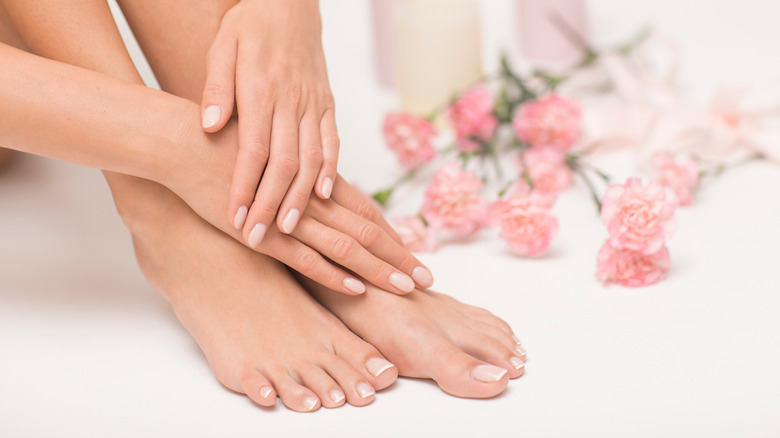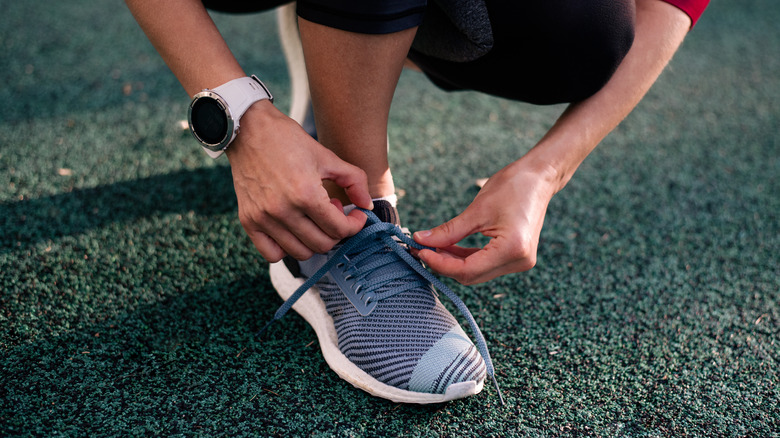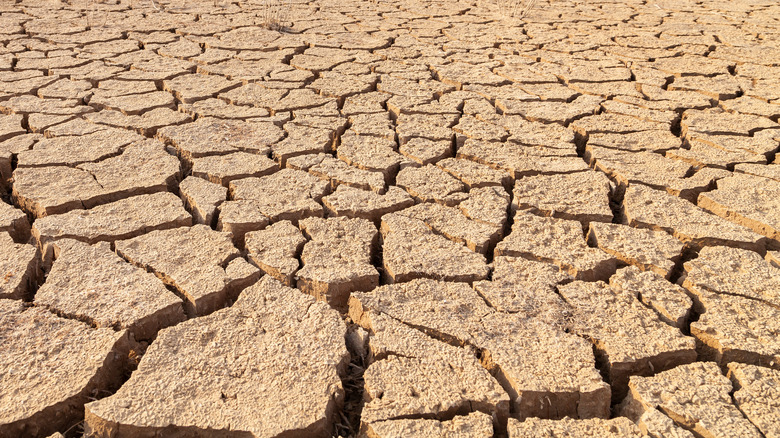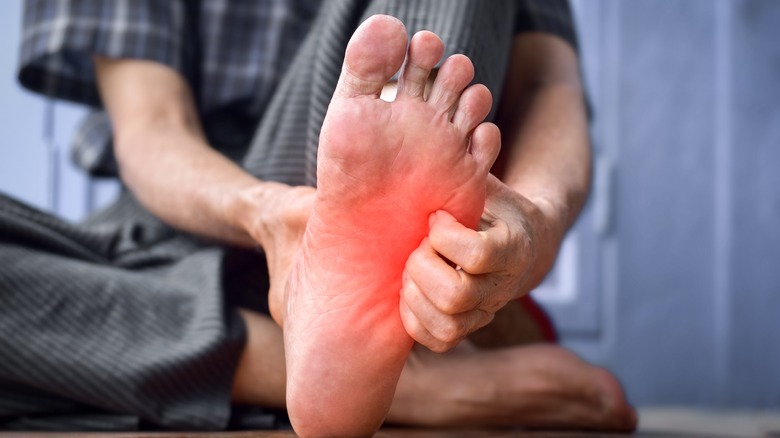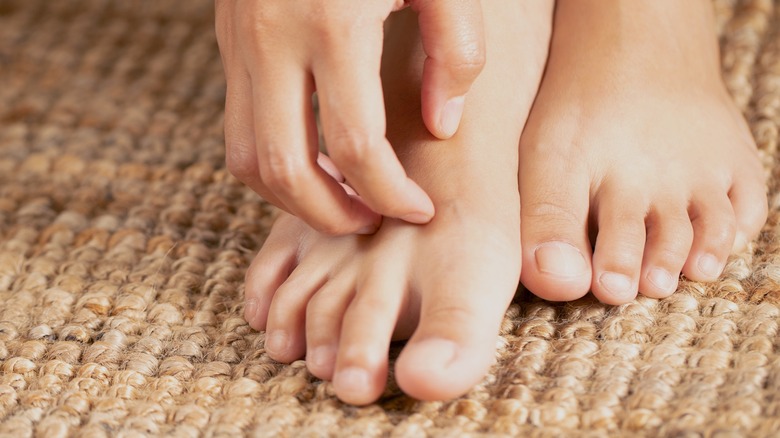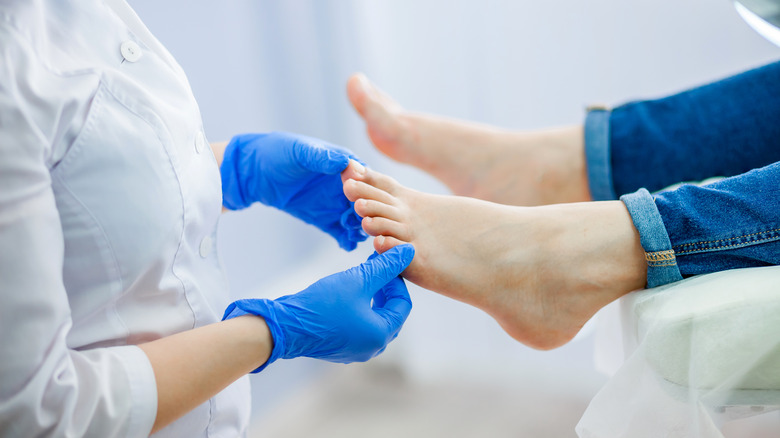What It Means When Your Feet Are Peeling
Peeling feet can be such a bother, and it can be embarrassing when it's time to get a pedicure. For the most part, peeling on your feet isn't a huge problem, according to Women's Health. After all, some of your sweatiest workouts could cause your feet to peel, and peeling is your body's way of getting rid of dead skin.
According to Buoy Health, your skin protects you from outside elements such as wind, sun, or pathogens, and it also has a moisture barrier to keep water inside. When it gets irritated, your skin might begin to peel, itch, burn, or become red. You might see cracked skin around your heel or the ball of your foot. The entire sole of your foot could peel from excess sweating. Your peeling feet could have many causes, depending on any accompanying issues like a rash or itch. Here are some of the most common causes.
You may have athlete's foot
Although athlete's foot usually causes your foot to itch, that's not necessarily the case. Athlete's foot can also cause your foot to peel. According to Healthline, you can get athlete's foot on just your toes or a single foot. It's usually accompanied by a rash, burning, and yes, itching. You get athlete's foot by coming into direct contact with someone who has it or by stepping on fungus on a surface like a shower floor. You can also get it if you share a towel with someone who has it.
If your foot peels and you think it might be a fungus like athlete's foot, be sure to get it checked out by a doctor. You can treat athlete's foot with an OTC antifungal spray. And you'll also need to spray your shoes. If possible, you want to prevent it from spreading to the toenail because it will continue to infect your foot. To prevent athlete's foot, keep your feet dry by changing any wet socks. And wear flip-flops or shower shoes when walking around the locker room at the gym.
You may be dehydrated
Dry skin can also cause your feet to peel, according to Healthline. You might naturally have dry skin, but dry air during winter months, hot showers, and excessive sun can dry out your skin as well. Dehydration is another common culprit, so be sure to drink plenty of water (via Women's Health). If the air is dry in your home, consider using a humidifier to help keep skin moisturized.
If you have dry skin, try taking lukewarm baths or showers instead of hot ones. Additionally, any time your skin is wet, use a fragrance-free moisturizer. Harvard Health Publishing suggests finding a moisturizer that can both hydrate and seal moisture in the skin. Ceramides, glycerin, and hyaluronic acid can help draw in moisture, and thicker ointments such as petroleum jelly can seal in the moisture. You can apply the ointments while the skin is still wet since they are oil-based.
You may have eczema
Eczema occurs when your body reacts to something harmless, according to Medical News Today. Because your body believes it's harmful, your skin can become inflamed. Although eczema usually occurs on the arms, you can also have it on your feet, according to Healthline. This could cause your feet to peel. You might have eczema if you get a rash or if the skin itches. Some eczema conditions could cause blisters as well. If you have the most common form of eczema, atopic dermatitis, it means that your immune system affects your skin's ability to hold moisture.
Although people experience eczema all their lives, you could develop eczema when you get older, according to Women's Health. You could ask your local pharmacist for a medicated cream to help with eczema's itch. Cortisone might help with the itching but use it sparingly because it causes the skin to weaken. Your podiatrist or dermatologist can also help by prescribing a special cream to help moisturize your skin.
You may have psoriasis
Psoriasis can cause your feet to peel because the body is reacting to healthy tissue and quickly generating new skin cells, according to Medical News Today. You can see thick patches of psoriasis on elbows, knees, and the soles of your feet, but they can appear on other areas. If you have psoriasis on your feet, the rash might appear gray at first but turn yellow. According to Healthline, psoriasis might flare up more often during winter months, stressful times, or when drinking alcohol. Psoriasis can be treated with topical corticosteroids or salicylic acid. Light therapy can help if the patches are on large areas of your body.
A dermatologist can also suggest thick moisturizers such as petroleum jelly to help with the flaking of the skin, according to Women's Health. This might make for a greasy situation walking around your house, so try putting socks on your feet after you moisturize.
When to see a doctor
Although you might already be seeing a doctor if you have psoriasis or eczema, other symptoms could accompany your feet peeling that warrant a check up. If your feet are swollen or you have blisters that ooze, you should consult a doctor, according to Healthline. You should also see your doctor if you tried moisturizing or OTC medications and your peeling persists. Peeling feet accompanied by a fever or signs of dehydration are also reasons to see your doctor.
To keep your feet healthy, take your shoes and socks off after sweating so your feet can dry and breathe, according to Red Mountain Foot Care. Bacteria thrive in dark, wet environments. A foot file can work well to rid your feet of dead skin and calluses. Start by soaking your feet in warm water for 20 minutes, then work the rough side of the file over the skin using a downward motion.

